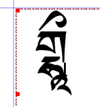Complex Script Functionality: Difference between revisions
| Line 21: | Line 21: | ||
==Tibetan & Dzongkha== | ==Tibetan & Dzongkha== | ||
'''Font:''' | |||
Jomolhari, a free Tibetan script font suitable for publishing is available from [http://chris.fynn.googlepages.com/jomolhari Jomolhari font] - OFL License. This font also works well with OO.org 2.4.x & Inkscape. | |||
'''Script & Language System tags:''' | '''Script & Language System tags:''' | ||
* Tibetan:tibt:TIB | * Tibetan:tibt:TIB | ||
* Dzongkha:tibt:DZN | * Dzongkha:tibt:DZN | ||
The following '''OpenType features''' should be processed to support Tibetan script: | The following '''OpenType features''' should be processed to support Tibetan script: | ||
Revision as of 04:11, 29 July 2008
Things we require for testing Complex Script Functionality
- Sample text files encoded in UTF8
- Sample screenshots of Scribus 1.3.3. or 1.3.4cvs rendering these incorrectly.
- Sample fonts that we can get that are freely available that have the ability to be used for DTP.
- Sample screenshots of any application rendering the same text correctly
An important point to note is we need comparable information. Same texts, same fonts etc and screenshots (png or tiff please) of said texts and fonts. --Cbradney 18:40, 25 Feb 2005 (UTC)
- Other usefull contribution would be mapping of the languages you're interested in with its script/lang pair in OpenType Font style.
example : French:latn:FRA
To help, you can have a look at http://www.microsoft.com/typography/developers/OpenType/scripttags.aspx for script tags and http://www.microsoft.com/typography/developers/OpenType/languagetags.aspx for lang tags. --Pmarchand 13:46, 8 April 2007 (CEST)
Arabic & Urdu
Free fonts for Arabic / Urdu are available by Crulp and by PakType. Licensing is GPL at PakType and Crulp has also very loose license.
Tibetan & Dzongkha
Font: Jomolhari, a free Tibetan script font suitable for publishing is available from Jomolhari font - OFL License. This font also works well with OO.org 2.4.x & Inkscape.
Script & Language System tags:
- Tibetan:tibt:TIB
- Dzongkha:tibt:DZN
The following OpenType features should be processed to support Tibetan script:
- ccmp - Glyph Composition / Decomposition (Composition = GSUB lookup type 4 & Decomposition = GSUB lookup type 2).
- blws - Below-base Substitutions (GSUB lookup type 4)
- abvs - Above-base Substitutions (GSUB lookup type 4)
- calt - Contextual Alternates (GSUB lookup type 6)
- blwm - Below-base Mark Positioning (GPOS lookup type 4,5)
- abvm - Above-base Mark Positioning (GPOS lookup type 4,5)
- kern - Kerning - (GPOS lookup type 2 or 8)
Note: The current version of the Jomolhari font uses only ccmp, blws, abvs, calt, and kern features. In kern only GPOS lookup type 2 (pair-adjustment) is used in this font ~ so this is the only kind of GPOS lookup used.
Tibetan Script Rendering Examples:
1. Test of ccmp feature used for Decomposition GSUB lookup type 2:
The string U+0F43 U+0F77 (གྷཷ) should render:

However, in Scribus 1.3.3.4, U+0F43 U+0F77 currently renders like this:

In this case, the ccmp feature should decompose U+0F77 into seperate glyph components to go below and above the glyph for the base character (U+0F43)
2. Test of ccmp feature used for Composition (GSUB lookup type 4):
The string U+0F42 U+0FB7 U+0F0B U+0F4C U+0FB7 U+0F0B U+0F51 U+0FB7 U+0F0B U+0F56 U+0FB7 U+0F0B U+0F5B U+0FB7 U+0F0B U+0F40 U+0FB5 (གྷ་ཌྷ་དྷ་བྷ་ཛྷ་ཀྵ) should render as follows:

However, in Scribus 1.3.3.4, that string currently renders like this:

In this case if ccmp feature is being applied ligatures should be properly composed.
Furthermore, the strings U+0F42 U+0FB7 U+0F0B U+0F4C U+0FB7 U+0F0B U+0F51 U+0FB7 U+0F0B U+0F56 U+0FB7 U+0F0B U+0F5B U+0FB7 U+0F0B U+0F40 U+0FB5 (གྷ་ཌྷ་དྷ་བྷ་ཛྷ་ཀྵ) and U+0F43 U+0F0B U+0F4D U+0F0B U+0F52 U+0F0B U+0F57 U+0F0B U+0F5C U+0F0B U+0F69 (གྷ་ཌྷ་དྷ་བྷ་ཛྷ་ཀྵ) should render identically as they are canonically equivalent. (U+0F42 U+0FB7 = U+0F43; U+0F4C U+0FB7 = U+0F4D; U+0F51 U+0FB7 = U+0F52; U+0F5B U+0FB7 = U+0F5C; and U+0F40 U+0FB5 = U+0F69.)
3. Test of blws feature (GSUB lookup type 4)